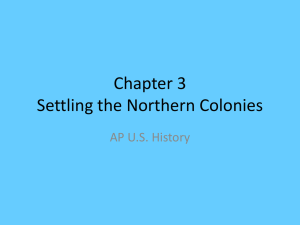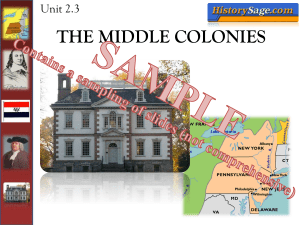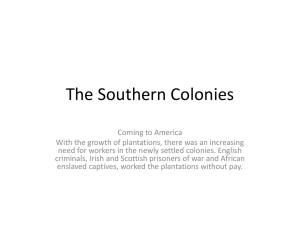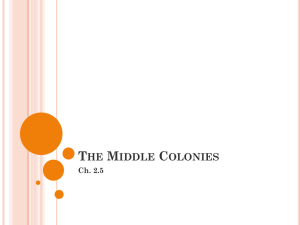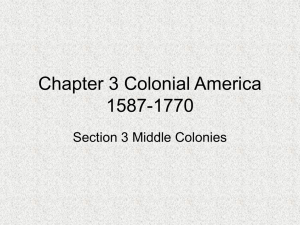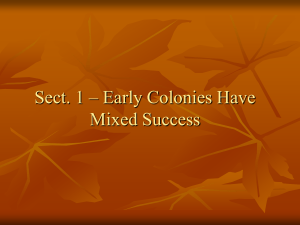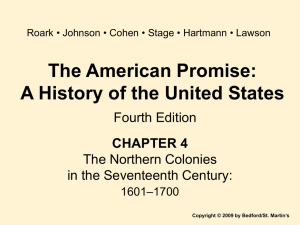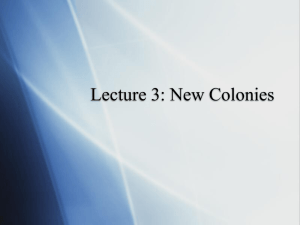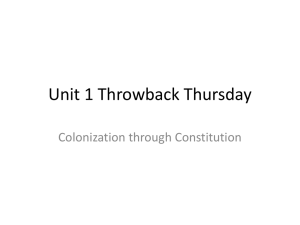2.4 Middle and Southern Colonies
advertisement
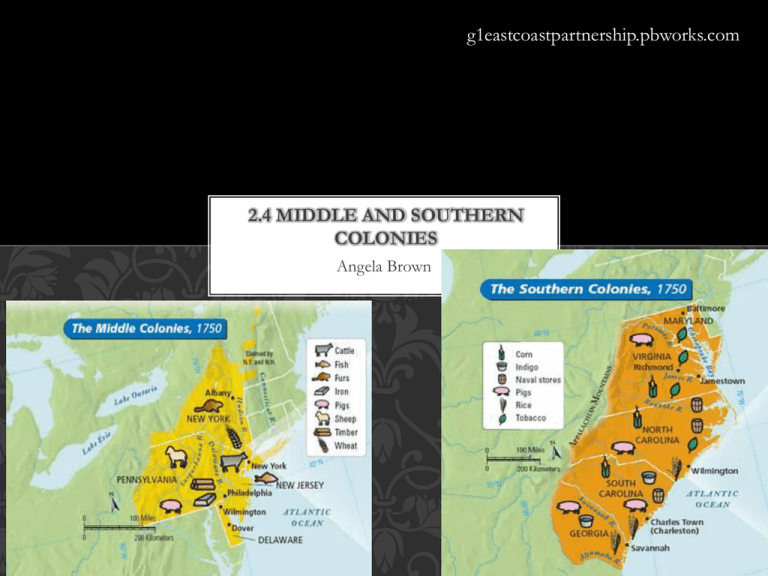
g1eastcoastpartnership.pbworks.com 2.4 MIDDLE AND SOUTHERN COLONIES Angela Brown FOCUS…. L ea r ni ng Ta rgets : Vo cab u la r y: I Can… 1. Explain the early history of the Dutch in New York. 2. Describe the founding of the other Middle Colonies. 3. Compare the reasons for settlement of the Southern Colonies. Middle Colonies, diversity, synagogue, proprietary colony, Quaker, haven, Southern Colonies, Trustee THE MIDDLE COLONIES • Settlers came from several different countries. • They are in the middle of the Atlantic coast of North America. • They had a great variety of people. • These colonies included New York, New Jersey, Pennsylvania, and Delaware. k12handhelds.com THE DUTCH IN NEW YORK • The first Europeans to settle in the area that is now NY were the Dutch. • They came from Holland, also called the Netherlands. • In 1621 Dutch investors formed the Dutch West India Company to develop trade in the Americas. • The company started the colony, New Netherland, in the Hudson and Delaware river valleys. • • • • A Thriving Colony In 1625, the Dutch began building a trading station called New Amsterdam at the mouth of the Hudson River. They built their homes on the island of Manhattan. The director of the colony, Peter Minuit, traded goods with the local NA for the right to use it. They company also built Fort Orange upstream, not far from the site of Albany, the modern capital of New York State. NEW YORK • The settlers soon built up a prosperous trade in furs and other goods with Europe. • The land was fruitful, the rivers navigable, and Indians brought furs to trade. • Farmers grew wheat and rye and more… shipping most of these products to other colonies. • Many diverse people carried on peaceful business at this port. • Some 18 different languages were spoken in its streets. • Religious tolerance was a firm rule. • They even had the first synagogue, or house of Jewish worship, on the NA continent. • Peter Stuyvesant, the governor, was often at odds with the colonies regarding their desire for self- government. • He refused to grant it. ENGLAND TAKES OVER • • • • • • In 1664 the English King, Charles II, declared the Dutch colonies belonged to his brother, the Duke of York. The Duke of York sent a fleet of four ships and several hundred soldiers to New Amsterdam. The town had no fort or other defenses, and the Dutch realized they could do nothing. Stuyvesant raged but in the end he was forced to give up the town. New Amsterdam was renamed New York and became an English colony. The rest of New Netherland surrendered to the English. paladium.net PROPRIETARY COLONIES • New York was a proprietary colony – a colony granted by a king or queen to an individual or group who had full governing rights. • Proprietor means “owner”. • It was owned by the Duke of York. • He could make laws and rule as he wished. • The other Middle Colonies were also proprietary. ushistory.org MIDDLE COLONIES New Jer sey • The Duke of York’s charter • included land in what is now Maine, NY, NJ, and Delaware. • He signed some over to two • English noblemen. • • It was divided into East Jersey and West Jersey. • East Jersey was closely linked • to NY. • West Jersey developed close • ties to Pennsylvania. • In 1702, they became the single royal colony of New Jersey. Delaware In 1638, settlers from Sweden started the first permanent colony in what is now Delaware. They built Fort Christina on the site of modern-day Wilmington. The Dutch under Peter Stuyesant captured this trading village. The Duke of York captured it from the Dutch. In 1682 he turned it over to the Englishman, William Penn, who allowed it to become a separate colony in 1704. PENNSYLVANIA • Delaware was not Penn’s only colony. • He had received a huge land grant from King Charles II of England in 1681. • He called it Pennsylvania, which means “Penn’s woods”. • Like the Puritans, he saw his colony as a “Holy Experiment.” • Unlike the Puritans, he wanted his colonists to practice religious tolerance. • He made agreements with NA for land use and then brought over the first settlers from England. • These settlers were Quakers, members of a Protestant group that had suffered persecution in England. • Quakers believed firmly that all people should be treated as equals, not only in church but in society and government. • Pennsylvania became a haven, or safe place, for people of every faith. QUAKERS • Quakers from other colonies, Wales, Germany and other countries came to Pennsylvania. • Non-Quakers were also invited. • Protestant groups such as the German Lutherans, Scotch-Irish, Presbyterians, and Swiss Mennonites built large settlements. • So many Germans settled in the colony that they became known as the Pennsylvania Dutch, after the German word Deutsch, which means “German.” civilwardailygazette.com THE SOUTHERN COLONIES • • • • • • • • • Virginia was the first-settled of the Southern Colonies. The others were Maryland, the Carolinas, and Georgia. All of these settlements began as proprietary colonies. Maryland Maryland started as the idea of George Calvert, an English lord who had become a Roman Catholic after growing up in the Anglican Church. He saw Roman Catholics being persecuted in England, and wanted to establish a safe place for them to live. He had also been a member of the Virginia company, and was convinced a well-run colonies could be profitable. In the early 1630s Calvert asked the king for a charter to establish a colony in the Chesapeake Bay area. The king approved his plan, but Calvert died before the charter could be written up. Thus it was issued in the mane of his son, Lord Baltimore. MARYLAND • In 1634 the first settlers arrived. • Though a haven for Catholics, Puritans also moved into the colony and outnumbered the Catholics. • Lord Baltimore ordered the adoption of a law that would protect Catholics from persecution called the Maryland Toleration Act. • It did not provided protection for non-Christians. • Puritans in Maryland’s assembly amended the law to state that nonChristians would be put to death. enchantedlearning.com MARYLAND PLANTERS • Planters in the 1600s grew prosperous by growing tobacco. • They began to use enslaved Africans to work their fields like Virginia. • By 1704, 15,000 of the 90,000 in the two colonies were slaves. • A Virginia law passed in 1642 penalized people for sheltering runaway slaves or indentured servants. • A 1664 Maryland law specified that all black people imported to the colony were to be given the status of slaves. scientificamerican.com THE CAROLINAS • King Charles II granted ownership to a group of English noblemen in 1663 despite earlier claims. • It was split into North and South in 1691 when two different governors were appointed. • In 1721, SC became a royal colony. • NC became a royal colony in 1729 • Both colonies thrived on trade with Native Americans and tobacco profits. costonscomplaint.blogspot.com GEORGIA • Georgia was set up like a proprietary colony in 1732, but was managed by trustees. • A trustee is someone entrusted to look after a business. • The trustees, led by James Oglethorpe, wanted to create a haven for English people jailed for failure to pay their debts. • The also had the duty of protecting the Southern Colonies against attack from Spanish raiders based in Florida. • Georgia was ruled strictly with no slavery, liquor or Catholics. • All types of Protestants were permitted. • The settlers lived in peace with the NA due to Oglethorpe’s negotiations. • The colonists forced the trustees to change the rules for liquor and slaves. • In 1752 the trustees gave their charter back to the King, and Georgia became a royal colony. EXIT SLIP: 1. Summarizing the main idea: List some of the reasons people settled in the Middle and Southern Colonies of North America. 2. Organizing Information: Create a chart showing the degree of religious tolerance in New York, Pennsylvania, Maryland, and Georgia. 3. Analyzing Time Lines: When and why was the Dutch colony of New Amsterdam renamed New York? 4. Predicting Consequences: Proprietors were able to make their own laws in the colonies. What do you think might be the consequences of this fact?
